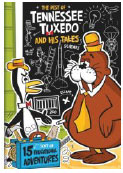






 |
 |
 |
 |
 |
 |
 |
|
| |
|||||||
|
Today, “Next Step” has a rather dubious reputation. It is remembered by many as rightfully short-lived and cheesily cheap. It was critically lambasted at the time of its original airing; “New York Times” TV critic John O’Connor called it a “silly little series.” And the cultish lovers of the original series have largely disavowed this ‘70’s relaunch. But for many of us, unfamiliar with the original “One Step” when we first discovered “Next Step,” the latter series occupies a pleasant—if nostalgia-soaked—place within our personal viewing histories. I first discovered it as mere lad growing up in central Illinois. I stumbled upon it—as one always stumbled upon things in those days—by simply flipping the dial. It was being aired on Saturdays, in the very early afternoons over WMBD, Channel 4, the CBS affiliate we got out of Peoria. At that age, the show didn’t strike me as anything but cool and creepy. In fact, it scared me out of Granimals! But as a great TV fan and one with a normal, youthful interest in the unexplained (that which scares us, intrigues us), every week I always came back to watch some more. The launch of “Next Step Beyond” was a direct result of the surprising post-cancellation success that “One Step Beyond” enjoyed in the 1960’s and early ‘70’s when in rerun. Like “Leave It to Beaver” and “Star Trek,” “One Step’s” earnest and eerie tales found a larger audience in its later, off-network repeats than it ever did during its original network run. Believing that the time was right for a remake, John Newland (then still quite busy as a TV director and producer) reteamed with his old executive producer, Collier Young, and “One Step” creator Merwin Gerard, to bring the series back to the small screen. Along with directing the show’s new episodes, Newland would, once again, act as the show’s host/narrator, our special guide into the foggy world of psychic phenomenon. Twenty-five episodes of “Next Step” were produced and aired. As John Kenneth Muir recounts in his fair and thorough book on both series, the remake series was almost immediately hobbled by budget concerns. Since the show was airing in first-run syndication, and not on network or under the auspices of a sponsor like its original Alcoa benefactor, the show’s per-episode budget was a measly $92,000. This restraint meant, among other things, that the show would have to cut corners by being shot on videotape as opposed to the more typical (for the time) film. The program’s reliance on the then relatively nascent technology of videotape gave the series, to many eyes, a low-rent aesthetic. Personally, I have never minded the look of videotape and always thought that it can give a production a feeling of almost hyper-realism; video is, after all, the currency of such actuality sources as home video and broadcast news. Far more problematic, however, was the show’s other cost-cutting tactic: recycling old scripts. Many of “Next Step Beyond’s” episodes were shot-for-shot, line-for-line remakes of some of its original installments. Though episode titles and proper names were often switched, basic storylines all stayed the same. For example, the “One Step Beyond” episode “Tidal Wave” from 1960 became “Next Step’s” debut episode “Tsunami.” The episode “The Return of Mitchell Campion” became “The Return of Cary DeWitt” and so on and so on. Of the second series’s 25 installments, 12 were remakes of old episodes. This regurgitation of scripts was probably the series’s eventual fatal flaw. Fans of the first series, from it originally airing or from its afterlife in repeats, were not only bored with these retreads but perhaps a little offended as well, hoodwinked into watching something they had, basically, seen already. In the end, such re-utilization also casts a pall over the show’s whole premise. If the idea behind “OSB”/”NSB” was to get us to believe, how could we when so much was being switched around and altered? If they were changing names, places and even eras, what other “facts” were they also playing with? The show certainly wanted to SEEM factual. Newland, as host, gives us very specific details about some aspects of the stories being told and the opening states that all these “case histories” have been “investigated and documented.” Also, to their credit, the show was not above being critical of exploiters, of psychic charlatans. In the final episode of the series, “To Fight a Ghost,” an alleged medium preying on a grieving woman is exposed as a fake in the show’s opening minutes. Still, for those of us youngsters who were, at that time, not familiar with the original series, we had no idea we were watching a remake and gobbled up these stories like they were being told for the first time! (In fact, I didn’t discover the original series until probably two years later when Chicago-based superstation WGN began showing repeats of “One Step” on Sunday afternoons in a one-two punch with episodes of “Twilight Zone.” What a revelation that was to see this whole other series. Regarding host Newland: “Hey, isn’t that that same guy?!”) Two (almost) complete episodes of “Next Step Beyond” are on Youtube. Meanwhile, the Library of Congress (my employer) has over 20 episodes in its collection. It was, to me, important to rewatch some of them to see how the second series holds up these days…and, of course, to relive some little bit of my childhood. As mentioned, in the revised series, John Newland is once again our calm and assuring guide, though now he’s fully grey-headed and adorned with a pair of thick-ish black glasses. The show is also, not surprisingly, in color. (This change to color was also big grievance for many original series loyalists who believed the show lost some of its earlier mood.) Additionally, though the caliber of guest stars that performed on the original series (which included the likes of Cloris Leachman, Elizabeth Montgomery, Christopher Lee, Joan Fontaine, Louise Fletcher and Warren Beatty) would never be matched, the reincarnated “Step” did include appearances by such beloved cult performers as Martine Beswicke, Majel Barrett, Robert Walker, Jr., William Campbell, James Keach, and Mark Goddard. In some ways, this works to the series’s advantage: with no major marquee names proving too distracting, it was easier, by and large, to buy into some of the paranormal goings-on.
And though sometimes the acting on some episodes is quite stilted (a byproduct of the show’s cost-saving rushed shooting schedule, no doubt) and some episodes seem a little padded (which, to be fair, so did many episodes of the original series), I found the majority of “Next Step Beyonds,” when watched today, still quite enjoyable. Granted, it is quite possible that my taste in TV entertainment has not expanded one iota since I was 10, but there’s also the fact that many of the show’s elements are still very viable. The music for the episodes is quite good and Newland’s opening narration and end-of-episode commentary sets just the right tone for what we’re about to see or just watched. And certainly Newland, who directed every episode of the revived series, remained assured behind the camera, he has a good story-telling sense and a good eye. The conclusion of episode #7, “Ghost Town,” is a vivid and as haunting as I remember it. Thankfully, I’m not totally alone in my assessment. Breaking with the chorus, Hal Erickson, author of the invaluable book “Syndicated Television, 1947-1987,” likes the series even if he does lament some aspects of it, for example its tendency to repeat stories. Granted, yes, some things in the new series are hard to pass by. Not the least of which is the now badly dated ‘70’s lingo (“foxy,” “disco”) and the fluffy, blown-out hair, polyester and plunging necklines (and that’s on the men!) that the show has become an unfortunate time capsule of. And, sometimes, as well, the video-based visual quality of the show works against it. Sometimes it looks like daytime drama and, sometimes, at worst, it looks like a local ad for a Midwestern car dealership. Other things were a tradeoff. Due to its limited budget, the series could seldom do period pieces; everything had to be set in present day, removing any hope for a gothic feel. But, then again, the show’s use of more easily mobile video cameras allowed them to go on location, a contrast to the usually studio-stuck original series. But if most of these trespasses are forgivable, what then foredoomed “Next Step” to just one nearly forgotten season? (And, more to the point, how come nobody had a psychic vision that it wasn’t going to last to begin with?) At the risk of a being a cop-out, Who knows? Hastening its demise might have been its often uneven airing in first-run syndication; I remember the episodes I tuned in for often being preempted by local or network sports coverage. Fans devoted to the original “One Step” probably thought the new show simply a rehash and stayed away. And, of course, trying to resurrect the genre of the anthology show has not really worked for the past 30 or so years and this new “Step Beyond” didn’t have enough bombast behind it to change that trend. And, finally, apparently, I guess there just weren’t enough excitable 10 year-olds in small Illinois towns in those days to keep the show on the air. Because, when it came to the show, I believed. I believed it was good. And, now, 30 years after the fact, I find I still do. |
The Next Step Beyond

Amazon Prime - unlimited streaming PR4 & PR5 Pages for Advertising
|
 |
 |
 |
 |
 |
 |
|
|
|
||||||||||
|
Save money! |